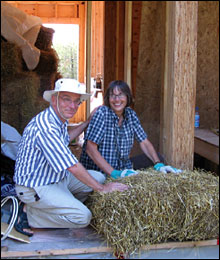Next: Nominate alumni in the public sector
Posted Jan. 11/07
When spring comes, Les MacDonald and Gwen Hoover will begin to plant their roof. It’s not for lack of gardening space.

- Thanks to his green home, Les MacDonald’s largest use of fossil fuel is on his occasional commutes to Ottawa. He acts as an advisor to Carleton faculty in planning research programs and writing winning funding proposals. MacDonald and Gwen Hoover laid the ceremonial first bale of straw in their home in August 2005.
The couple’s 10-acre property of meadow, wildflowers and trees on the shore of the Bay of Quinte in Prince Edward County, ON, provides all the vegetation they desire.
By adding six inches of soil on top of a membrane on the roof and planting it with sedum, a low-growing, drought-resistant succulent, the couple will create a natural air conditioner in the summer and provide extra insulation in the winter. It will also be the last major project to complete their off-grid, eco-friendly home.
The journey for the former Ottawa cultural bureaucrats from downtown Ottawa to down by the shore began three years ago. MacDonald, MA/74, PhD/85, retired as director of Strategic Programs and Joint Initiatives at the Social Science and Humanities Research Council, where he’d worked since the 1970s. Hoover left her position with the Public Lending Right Commission, and they “moved south” where they could pursue sailing and MacDonald could resume astronomy.
“When we lived in the city, the infrastructure conspired against conservation. Power wasn’t individually metered in our condominium, for example, so we had a good excuse for doing little for the environment,” says MacDonald. “In building our retirement home, we had the opportunity to control the variables. We wanted to build a comfortable, aesthetically pleasing home that was environmentally responsible.”
Just how environmentally responsible the house would be came as a bit of a surprise.
With the chosen building site 500 meters from the road — and the hydro lines — the cost of running power to the home shot up dramatically. That’s when architect Martin Liefhebber, the winner of a Canadian Mortgage and Housing Corporation (CMHC) sponsored design competition for an off-grid home in Toronto, persuaded them to leave the power lines behind.
“The house cost more to build than a regular house, and if the cost of running power lines in hadn’t been so high, we probably wouldn’t have considered this option,” says MacDonald. “Essentially, we capitalized all our energy costs, paying them upfront in the construction of the house.”
The three-bedroom, three-bathroom house features passive solar heating, a hydronic radiant flooring system, a masonry stove, solar electric panels and a wind turbine. Backup heat is rarely provided by a propane boiler.
The south-facing wall, consisting largely of energy-efficient windows, allows winter but not summer sun into the house. The straw bale walls on the other sides offer a healthier internal environment, as the permeable plastered walls allow vapour to travel to the outside while providing a superior insulation value overall compared to conventional walls.
“Our challenge was trying to acquire knowledge in so many areas quickly enough to fit the building schedule. We were our own system integrators, providing the link between contractors who knew their own systems but not how the whole house would interact,” says MacDonald.
“As far as government support went, we were on our own, which is disappointing given the salience of the environment.”
“While CMHC offers encouragement for responsible technology in building, building practices tend to be conservative. Avoiding risk means builders avoid new technology and investments that could raise the cost of a house,” says MacDonald. “I think if consumers were better informed, they would be willing to pay more upfront for long-term savings. As the Ontario government allows the price of power to approach the cost of producing it, maybe more people will think of true costs, which include the social and environmental price too.”
What difference can one house make in our energy-guzzling society?
“People think one house doesn’t make a difference, but it provides an example of individual action within limited options,” says MacDonald, whose house attracts a lot of attention in Prince Edward County. In November, conservationist David Suzuki visited the house to film a feature for the CBC’s The Nature of Things on its use of natural resources for energy.
Besides, for MacDonald, watching the sun rise over the trees from his solar-powered house is its own reward.